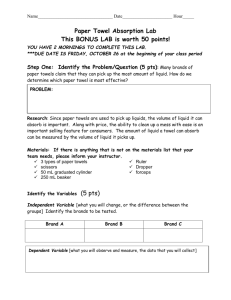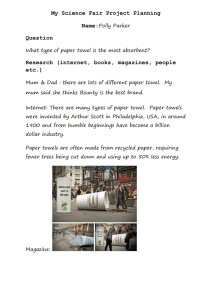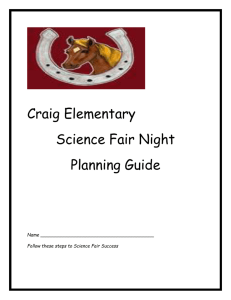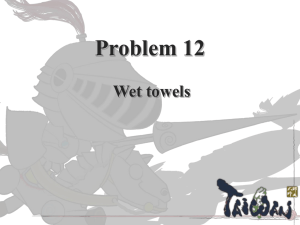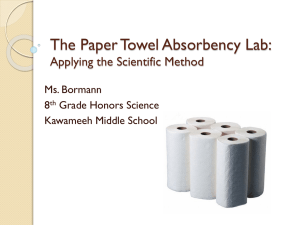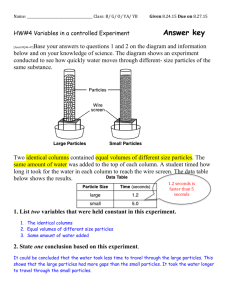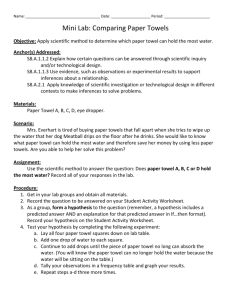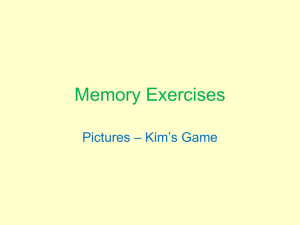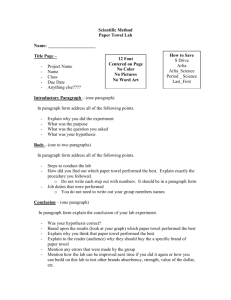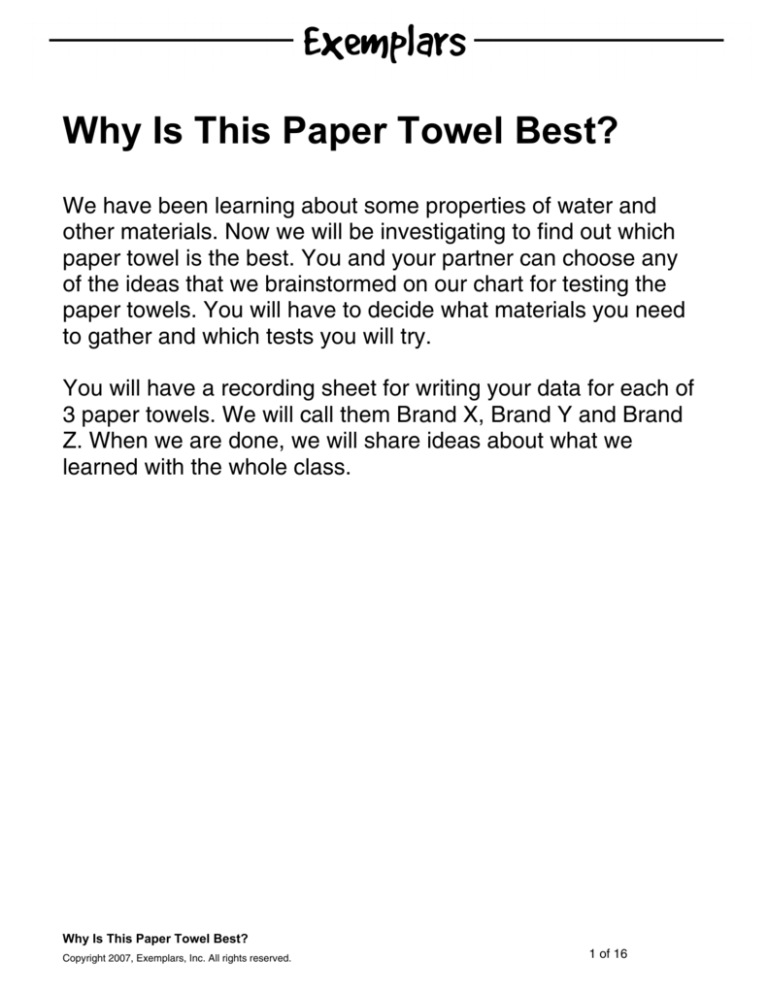
Why Is This Paper Towel Best?
We have been learning about some properties of water and
other materials. Now we will be investigating to find out which
paper towel is the best. You and your partner can choose any
of the ideas that we brainstormed on our chart for testing the
paper towels. You will have to decide what materials you need
to gather and which tests you will try.
You will have a recording sheet for writing your data for each of
3 paper towels. We will call them Brand X, Brand Y and Brand
Z. When we are done, we will share ideas about what we
learned with the whole class.
Why Is This Paper Towel Best?
Copyright 2007, Exemplars, Inc. All rights reserved.
1 of 16
Why Is This Paper Towel Best?
Suggested Grade Span
K–2
Task
We have been learning about some properties of water and other materials. Now we will be
investigating to find out which paper towel is the best. You and your partner can choose any of
the ideas that we brainstormed on our chart for testing the paper towels. You will have to decide
what materials you need to gather and which tests you will try.
You will have a recording sheet for writing your data for each of 3 paper towels. We will call
them Brand X, Brand Y and Brand Z. When we are done, we will share ideas about what we
learned with the whole class.
Big Ideas and Unifying Concepts
Cause and effect
Change and constancy
Physical Science Concept
Properties of matter
Mathematics Concepts
Comparison of attributes or effects
Counting
Data collection, organization and analysis
Measurement
Time Required for the Task
Approximately 45 minutes (split in two sessions over two days).
Context
This scientific investigation was an engaging activity that encouraged my first graders to
actively compare paper towels. This is an example of a culminating activity connecting many
concepts that had been explored about the properties of matter, especially liquids and solids.
The students had previously completed activities involving cohesion, adhesion, capillary action,
Why Is This Paper Towel Best?
Copyright 2007, Exemplars, Inc. All rights reserved.
2 of 16
absorption and surface tension. Then they brainstormed possible fair-testing tasks for three
unknown brands of paper towels to be investigated with their partners.
What the Task Accomplishes
This task combined several concepts learned about the properties of liquids (water) and solids
(paper towels plus other tools used). This culminating task reinforced the students’ skills and
knowledge about controlling variables, using tools, developing strategies, communicating their
findings and gathering data to support or alter their predictions.
One of the tests chosen by the class demonstrated absorption, which is the process by which
one substance takes in another, such as the paper towel soaking up a controlled amount of
water. Another test involved controlling variables for strength. The students determined how to
control (how many) drops of water placed on the center of the paper towels and how hard a
“tug” should be. A third test related back to the study of how fast objects fall and how they are
affected by their weight in the air. The students tested to see if there was a difference in the
weight of the paper towels by how fast they landed on the floor when dropped from a specific
height. Another absorbency test involved making a controlled spill, wiping up the water,
squeezing the water from the paper towel and measuring the liquid.
How the Student Will Investigate
Before beginning the investigation, I had the children brainstorm why we needed paper towels.
Responses included: "wipe your mouth," "clean the kitchen," "we don’t use them at our house,"
"clean up spills," "put water to clean a cut," "dry your face from the rain," "clean an accident on
the floor," "wipe sticky hands," "dog/cat accident" and "pick up 'yucky' stuff." Then we began to
talk about how we could decide which paper towel to choose for the job.
The students were not told which brands of paper towels they were investigating, in order to
provide fair testing of these consumer products. Each paper towel had a distinctly different
design so children would not get them confused. They were torn into equal sections and placed
in separate plastic bins for easy access. Students brainstormed on chart paper a variety of
testing situations for the paper towels. I also reviewed earlier activities with them, by asking
questions: Do you remember when we did this? and What could be done that was similar? This
helped them think back to previous experiments if they were feeling stuck for ideas. I also
asked them which tests would be easier/harder, what materials did we need to gather and
which test would they try first, second, third, fourth, etc. This helped to decrease any confusion
in gathering materials and allowed me to observe their strategies and data keeping in a
consistent manner. I decided to spread this investigation over two class periods during the
same week, which provided more time to investigate, observe, discuss with partners, draw
conclusions and exchange ideas as a whole class.
Why Is This Paper Towel Best?
Copyright 2007, Exemplars, Inc. All rights reserved.
3 of 16
Interdisciplinary Links and Extensions
Science
Further proof of classroom testing might include having the children bring home samples of
each paper towel to test in the same ways or to conduct different tests, which would involve
their families deciding which paper towel was the best.
Since this task drew on activities involving cohesion, adhesion, capillary action, absorption and
surface tension, other ways to connect these concepts at home might include having students
observe what happens when letting cereal get soggy, soaking some spaghetti noodles, drying
off with a towel after a shower or mopping up spills. Where does the water/liquid go? How does
it get there? (capillary action) On a clothesline, test to see which items (jeans, socks, sheet,
nightgown, pillowcase, flannel shirt, etc.) would dry faster. Can you explain why?
Social Studies
Examine a variety of fabrics for their ability to absorb liquid or heat. Test which ones are best for
a raincoat, mitten, tablecloth, washcloth, blanket, napkin and kerchief and explain why. Why do
we wear light colors in summer and darker colors in winter?
Literacy/Art
Integrate the book Did You Hear Wind Sing Your Name?: An Oneida Song of Spring, by Sandra
De Coteau Orie, which illustrates the beauty of nature and Native American respect for the
environment. Use the book, Water, by Frank Ash, and have children watercolor their own
booklets about how many different places we can find water (e.g., puddles, dew drops, fog,
rain, ocean, stream, swamp, etc.) Dip coffee filters in colored water, or drip colored water onto
filters, and use the paper to write poetry on. Mrs. McNosh Hangs Up Her Wash, by Sarah
Weeks is a book that encourages rhyming while playing with language and the impossible
weights of objects on the wash line. Children can make their own art representations of an
“impossible wash” hanging to dry.
Music/Movement
Children love to move their bodies to music, which can be integrated with science in a
meaningful way to reinforce concepts. Read the story, Roger’s Umbrella, by Daniel Pinkwater
about the title character’s adventures with a naughty umbrella. Collaborate with the music
teacher by taking a song about a familiar water experience and using musical instruments to
represent the weather or actions of a story.
Mathematics
Compare measurements of rainfall in a rain-forest habitat with that in your state’s forest habitats
and discuss what happens once the water is absorbed into the soil. These could include making
bar graphs and discussing similarities and differences.
Why Is This Paper Towel Best?
Copyright 2007, Exemplars, Inc. All rights reserved.
4 of 16
Teaching Tips and Guiding Questions
These questions might encourage inquiry and investigation before, during and after the testing
of paper towels:
• What are your predictions about the quality of the paper towel? Try looking at/examining
the weave, texture or thickness before our testing investigations (provide hand lenses).
• Which one do you predict will absorb more water? Why?
• Which one do you predict will be stronger? Why?
• Find out which brand of paper towels your family uses. Why does your mom or dad like
that brand best?
• How will we control the variables for our test of absorption?
• How will we control tugs for our strength testing? What could be a problem with this testing?
• When we float the paper towel on the water, what objects can be used for weight? Were
there any problems with any of the objects that were chosen?
• What do you notice about each of the three paper towels after putting water on them?
Were you surprised by any one towel? Why?
• How do you think these results might be different/similar when using the brown school
paper towels? How could we find out?
• Did one paper towel brand test the best for everything or only some things? Why?
• Based on your data, which paper towel would you choose to buy for your family? Why?
Concepts to be Assessed
(Unifying concepts/big ideas and science concepts to be assessed using the Exemplars
Science Rubric under the criterion: Science Concepts and Related Content)
Physical Science – Properties of Matter: Students observe physical properties of paper towels
and sort according to similarities and differences.
Scientific Method: Students observe and explain reactions when variables are controlled
(cause and effect). Students determine the patterns and/or which kinds of change are
happening through data (change and constancy).
Mathematics: Students use number sense and counting, understand and apply graphing and
probability, and use numerical data/measurements in describing events, answering questions
and providing evidence for scientific explanations. Students compare attributes or effects.
Why Is This Paper Towel Best?
Copyright 2007, Exemplars, Inc. All rights reserved.
5 of 16
Skills to be Developed
(Science process skills to be assessed using the Exemplars Science Rubric under the criteria:
Scientific Procedures and Reasoning Strategies and Scientific Communication Using Data)
Scientific Method: Observing, predicting, hypothesizing, collecting/recording data, controlling
variables, manipulating tools, drawing conclusions, communicating findings and raising new
questions.
Other Science Standards and Concepts Addressed
Scientific Method: Students describe, predict, investigate and explain phenomena. Students
control variables.
Scientific Theory: Students look for evidence that explains why things happen and modify
explanations when new observations are made.
Physical Science – Properties of Matter: Students describe and sort objects and materials
according to observations of similarities and differences of physical properties.
Communication: Students use verbal and nonverbal skills to express themselves effectively.
Students interpret and communicate and use mathematical, scientific and technological
notation and representation.
Mathematics: Students use reasoning strategies, knowledge and common sense to solve
complex problems related to all fields of knowledge.
Suggested Materials
I chose three brands of paper towels that were different in texture and design, ripping them into
smaller sizes ahead of time for testing. I also provide plastic rectangular tubs for desk groups to
help contain water spills; manipulatives to place weight on the paper towels, such as color tiles,
wooden blocks, toy cars, shells; eyedroppers; plastic cups of water; one-inch color tiles for
measuring size of absorption; and small medicine cups (1 and 1/2 fl. oz.) to measure ml of
water left.
Students are given a recording sheet with four columns: a small column for the testing concept
and three larger columns to record the testing results of each brand of paper towel (X, Y, Z).
Lines were included on the back of the sheet to record conclusions made after each testing
activity. I also included three boxes at the top to record the designs and other attributes about
the paper towels before the investigations began.
Why Is This Paper Towel Best?
Copyright 2007, Exemplars, Inc. All rights reserved.
6 of 16
Possible Solutions
The solutions will vary for each child depending on the variables that were selected for testing
(controlled/not controlled) and the accuracy of observations that were recorded. It is possible
that a paper towel might not have the best of all qualities tested. I looked for the accuracy of
their recordings and how they made an overall conclusion about which paper towel was the
best to purchase, based on their scientific findings. At the top of the recording sheet,
observations about the characteristics of each towel should be recorded. The first test (soaks
up) was a controlled spill of five drops of water, which was measured with unifix cubes after one
minute. The second test (weight) demonstrated how the weight of the paper towel was affected
by air when dropped. The third test demonstrated how strong each paper towel was by having
the same person tug it the same way each time until it ripped. The final test involved a spill of
one tablespoon of water, wringing the excess water out and measuring the amount of liquid left.
Task-Specific Assessment Notes
Novice
This student’s solution is incomplete (all data are not recorded), and the explanations do not
demonstrate a strategy that shows reasoning using the scientific concepts. The drawings and/
or the labeling are not complete. The word “strong” is used for the weight of the paper towel
tested. The activity with tugs (strength) is recorded incorrectly. There is not enough evidence
recorded to pick the best choice of paper towel based on the attributes.
Apprentice
This student’s solution is complete, and there is some attempt to show reasoning using
scientific concepts. Data are collected and drawings are labeled appropriately; however,
conclusions are unclear and confusing. Data do not support the conclusion on the weight test;
the strength (tugs) was incorrectly recorded because Brand X was observed as two tugs in the
group working with this student. Instead of stating “the best” in this student’s conclusions,
results should reflect pertinent vocabulary like strongest, lightest, soaks up the most or absorbs
better. The student did record a final choice of paper towel but without a reason. The
procedures followed did indicate some understanding of the scientific concepts, but an inability
to link cause-effect reasoning.
Practitioner
This student’s solution is complete, and there is evidence about how the student tested and
gathered data. Drawings are labeled appropriately. The student uses data to make accurate
scientific conclusions about the brands of paper towels. Results are stated clearly with respect
to each test conducted. The student understands the relationship of cause-effect and effectively
used tools and labeling to support the accuracy of the final conclusion.
Expert
This student’s solution is complete and detailed. This student provided more ideas under preopinions about the attributes of the three brands of paper towels, which is the primary difference
between this and the Practitioner sample. In these observations, the student demonstrates
Why Is This Paper Towel Best?
Copyright 2007, Exemplars, Inc. All rights reserved.
7 of 16
evidence of prior knowledge and experiences about absorption, measurement and the effect of
air on objects, noticing attributes of the paper towels prior to the task. There is clear evidence of
scientific reasoning, in that each concluding statement is supported by the data.
Why Is This Paper Towel Best?
Copyright 2007, Exemplars, Inc. All rights reserved.
8 of 16
Novice
Why Is This Paper Towel Best?
Copyright 2007, Exemplars, Inc. All rights reserved.
9 of 16
Novice
Why Is This Paper Towel Best?
Copyright 2007, Exemplars, Inc. All rights reserved.
10 of 16
Apprentice
Why Is This Paper Towel Best?
Copyright 2007, Exemplars, Inc. All rights reserved.
11 of 16
Apprentice
Why Is This Paper Towel Best?
Copyright 2007, Exemplars, Inc. All rights reserved.
12 of 16
Practitioner
Why Is This Paper Towel Best?
Copyright 2007, Exemplars, Inc. All rights reserved.
13 of 16
Practitioner
Why Is This Paper Towel Best?
Copyright 2007, Exemplars, Inc. All rights reserved.
14 of 16
Expert
Why Is This Paper Towel Best?
Copyright 2007, Exemplars, Inc. All rights reserved.
15 of 16
Expert
Why Is This Paper Towel Best?
Copyright 2007, Exemplars, Inc. All rights reserved.
16 of 16

